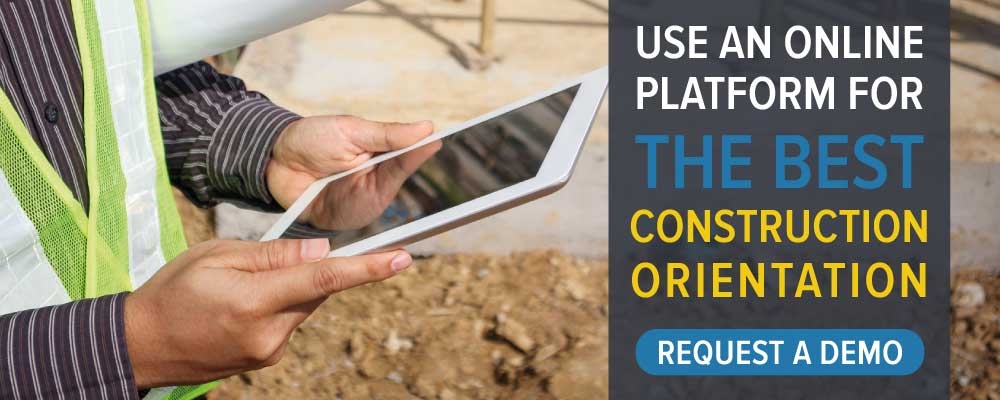
The Costs and Importance of a Safety Manager
If a Safety Manager is not employed, the orientation process should be carried out and followed up on by a qualified Site Manager or Supervisor. The costs of performing this work can vary, but burdened costs are usually $50 an hour or more. Planning and performing the construction site safety orientation is not their only job. Along with every orientation, there needs to be paperwork providing necessary information, such as safety policy sign-offs. Generally, the person carrying out the orientation will be in charge of its safe storage, as well as the follow-up and tracking of training and documentation records, e.g. incident reports, injury and illness records. All workers should be provided with a useful and relevant construction site safety orientation before their job on-site begins.A Successful Construction Site Safety Orientation
The orientation of a new worker usually takes place during normal working hours and should be related to their employment. Once a worker has been successfully onboarded, they should be aware of any important health and safety details and have the skills to be a productive member of the workforce. After a successful construction site safety orientation process has been performed, any paperwork involved should be stored in the correct location and kept up-to-date over time. Important documents to be stored include, but are not limited to:- Safety orientation/training records
- Written safety policies and procedures
- Employee medical and exposure records
- Incident reports
- Injury and illness records

Accurate Storage of Paperwork
Additional space is needed to store this paperwork and an incorrect location could make it difficult, even impossible to retrieve again. There are a lot of files which will be required again over time, maybe in the event of an accident. Penalties can be given if important documents cannot be found or have been accidentally destroyed. Unlike paperwork, online documents are easily searchable and can be viewed from any location. This can save time for the person doing the searching, freeing them up to spend time on their own job. The removal of any out of date documents can save the cost and hassle of storage space, e.g. expensive but unnecessary filing cabinets.Correct Use of Up-to-Date Details
The costs of keeping these documents up-to-date are ongoing over time, with the same person likely to be in charge of following up and keeping track of training and documentation records. Although these costs are ongoing, the accidental use of incorrect details could result in fines, e.g. written risk assessments which have not been kept up to date, or a lack of relevant contacts in the case of an accident. Part of this job should include the removal or replacement of files which are now out of date.The Cost of Falling Through the Cracks
Preparing contractors for their new job before they start will make sure that everyone is ready to begin with no one falling through the crack. If even one worker does not conform to safety regulations when they begin, the entire company could be put at risk for non-compliance. Research into accidents at construction sites has shown workers’ behavior and safety culture to be a major cause. If the management enforces, teaches, and supports safety regulations themselves – being aware of any possible accidents involved – workers will be more likely to conform to health and safety requirements. Keeping up these complex but critical standards will likely result in a significant cost saving over time. Extra costs could caused by:
Keeping up these complex but critical standards will likely result in a significant cost saving over time. Extra costs could caused by:- Production loss, due to absence from work and re-organization of work involved
- Stoppage of work but still paying the injured worker
- Hiring and training of a replacement worker
- Repair or replacement of damaged material, property, or machinery
- Administrative time spent by supervisors, safety personnel, clerical workers
- Loss of orders and/or clients, turned-off by a poor company image
- Fines and/or an increase in premiums
- First-aid and an analysis of the case details
Conclusion
It is a good idea to create a standard orientation, providing every worker with the minimum amount of information needed, including health and safety requirements. You can then add more site-specific content depending on a worker’s role. An orientation process may appear to have high costs in the beginning, but over time is likely to make sure that new workers are always prepared for the job involved, with details kept up-to-date in a safe environment. An online contractor management system like GoContractor is the ideal solution to ensure that your construction site safety orientations lead to productive and safe workers. Costs involved, which should always be accounted for over time, include:- Cost per hour of hiring a relevant safety or site manager to train workers
- Cost per hour of hiring this manager to store documents
- Cost per hour of hiring this manager to keep documents up-to-date
- Salary of the new worker being trained
- Storage space or containers for important documents
